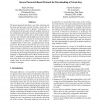109
Voted
SCN
2010
Springer
14 years 10 months ago
2010
Springer
This paper introduces and explores the new concept of Time-Specific Encryption (TSE). In (Plain) TSE, a Time Server broadcasts a key at the beginning of each time unit, a Time Inst...
104
Voted
SCN
2010
Springer
14 years 11 months ago
2010
Springer
An identity-based encryption (IBE) scheme can greatly reduce the complexity of sending encrypted messages. However, an IBE scheme necessarily requires a private-key generator (PKG)...
100
click to vote
CSREASAM
2006
15 years 2 months ago
2006
- This paper proposes a "mechanism-based PKI", in which only a mechanism for generating user's private keys is installed on a smart card. The private key is generate...
104
click to vote
FC
1997
Springer
15 years 4 months ago
1997
Springer
Abstract. SPEED is a private key block cipher. It supports three variable parameters: (1) data length — the length of a plaintext/ciphertext of SPEED can be 64, 128 or 256 bits. ...
118
click to vote
SACRYPT
1998
Springer
15 years 4 months ago
1998
Springer
In 1998, Cai and Cusick proposed a lattice-based public-key cryptosystem based on the similar ideas of the Ajtai-Dwork cryptosystem, but with much less data expansion. However, th...
105
Voted
SP
1999
IEEE
15 years 4 months ago
1999
IEEE
A sensitive point in public key cryptography is how to protect the private key. We outline a method of protecting private keys using cryptographic camouflage. Specifically, we do ...
107
Voted
NDSS
1999
IEEE
15 years 4 months ago
1999
IEEE
We present protocols that allow a user Alice, knowing only her name and password, and not carrying a smart card, to "log in to the network" from a "generic" wo...
100
Voted
EUROCRYPT
2001
Springer
15 years 5 months ago
2001
Springer
NTRU is a fast public key cryptosystem presented in 1996 by Hoffstein, Pipher and Silverman of Brown University. It operates in the ring of polynomials Z[X]/(XN − 1), where the ...
132
Voted
EUROCRYPT
2010
Springer
15 years 5 months ago
2010
Springer
In this paper we propose a new approach to investigate the security of the McEliece cryptosystem. We recall that this cryposystem relies on the use of error-correcting codes. Since...
137
click to vote
ISW
2004
Springer
15 years 6 months ago
2004
Springer
In key-insulated cryptography, there are many private keys with different indexes and a single, fixed public key. When the trust model includes multiple Certification Authoritie...




